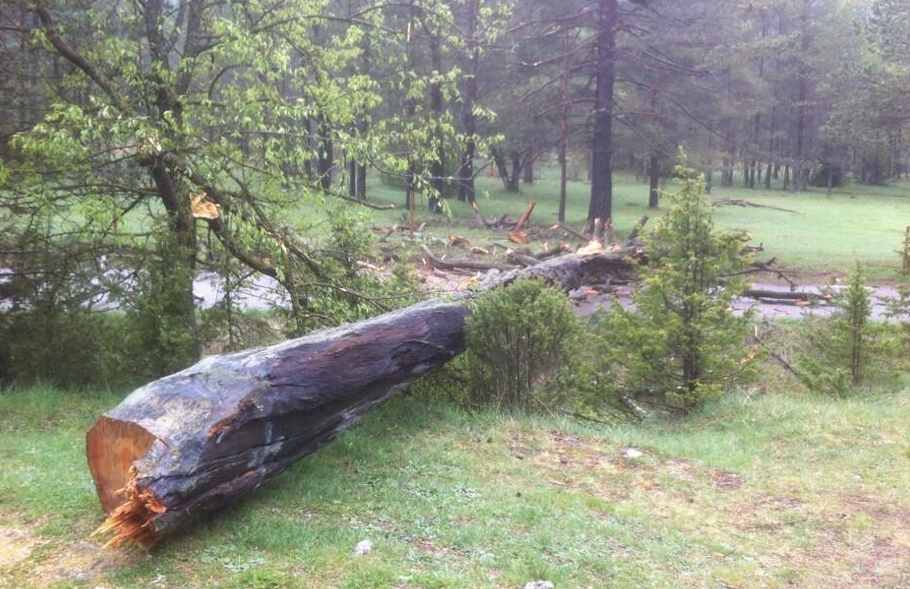13.05.2014 - 13:01
The Three Branch Pine Tree, that symbolizes the Catalan Countries has been vandalized, having one of its branches completely sawed off. But what are the Catalan Countries? In this essay, excerpted from What’s up with Catalonia?, journalist Vicent Sanchis helps explain why this vandalism goes to the heart of the Catalan sovereignty debate.
Catalonia or Catalan Countries?
by Vicent Sanchis
(An excerpt from the book What’s up with Catalonia?: The causes which impel them to the separation (Catalonia Press, 2013)
What is the “Catalan Nation” and what does that expression even mean? Most of the visitors who come to Catalonia each year are tourists and they don’t have the slightest idea. At the best, maybe they’ve heard of Gaudí or Barça. And that Gaudí and Barça are the highest expressions of art and sports, respectively, of a land, Catalonia, that is a region, a part of Spain. A Spain that has expressed itself exclusively in Spanish and whose most recognized and celebrated characteristics are bullfighting and flamenco dancing. Even today. There are so many people who never have the chance to notice a different reality. A more genuine “difference”. There are many more who go back home without having heard a word of the Catalan language. And those who return home with a few broad superficial strokes that simply confirm the few stereotypes they brought with them. And they do it with an Andalusian guitar, a bullfighter’s hat, or an Andalusian doll that they bought on the Rambles in Barcelona as the most representative expression of what is “Made in Spain”. Or even worse: sometimes the souvenir with which they remember their journey is a sombrero from Mexico!
But it is also increasingly true that some of these visitors, before they step foot in Catalonia have received news about a different reality. One that affirms that Catalonia is not a region, but an old European nation that gets on the best it can—and over the centuries has made the best of—living in a state called Spain. A state that hides within various diverse national realities, especially from the outside world. That tries to dilute them. This knowledge, that destroys old preconceptions and stereotypes, has grown steadily since 1.5 million Catalans came out to demonstrate on September 11, 2012, demanding the independence of Catalonia. Regions don’t demand independence. Only nations do. Given this logic, some of the visitors and the curious now close in on the Catalan reality from a new perspective, with different information facilitated to them by the media of their own countries. It is in this way that Catalans are beginning to be known internationally as a “special case”. Like the Irish, the Scotch, or the Quebeckers.
But now that we’ve gotten to this point, which just a short time ago seemed so difficult to reach, it’s time to go one step farther. The definition of the Catalan Nation is neither mathematic nor singular. For most Catalans who live in the four Spanish administrative provinces that have their own autonomous regime—called “Catalonia”—the Catalan Nation goes no farther than that territory: Tarragona, Lleida, Girona and Barcelona. A country that on geographical maps of the Iberian Peninsula is bordered by the Pyrenees mountains and the Ebre and Sénia Rivers. But the political Catalanism—from the time of Enric Prat de la Riba (1870–1917) one of its most influential theorizers—often proposed a different reality. More complicated and more difficult still.
A reality that comprises all of the territories where Catalan is spoken and that from the 12th until the 18th century formed a political unit called the “Crown of Aragon”. A unit formed by various territories—the Principality of Catalonia, Aragon, the Kingdom of Valencia and the Kingdom of Mallorca—forged from the Christian conquest of the Muslim territories from the Pyrenees onward in a long process that began in the 9th century and didn’t end until the 13th. Each with their own laws and privileges that were abolished after their defeat in the so-called War of the Spanish Succession (1701–1715).
Presently, those territories make up distinct “autonomous communities” within the current territorial structure of the Spanish State, in force since the approval of the Constitution of 1978. There is, therefore an “autonomous community” of Catalonia, one of Valencia, one of the Balearic Islands, and one of Aragon. There are also a few counties around the city of Perpignan that Spain ceded to France as a consequence of one of the wars the two countries had in the 17th century and which now belong to French “départements”. All of these territories, colonized by Catalans, shared—and continue to share today—the Catalan language and culture.
And it is this common language and this common culture which distinguish and define our different nation. A concept that, in present-day terms, incorporates not only “Catalonia” but also the Valencian Country, the Balearic Islands, the part of Catalonia administered by France, and a long strip of Aragonese territory that also has Catalan as its language. The concept, therefore, of a Catalan nation is even wider. There are a lot of people who reduce it to a strictly cultural environment. The “Catalan nation” is for them, a cultural phenomenon—like “Francophonie” is for the French.
There are also a lot of people who demand such a definition politically. There are many Valencians, Mallorcans, Menorcans, or Aragonese who feel nationally “Catalan”. The most brilliant defender in favor of this political option is the Valencian writer Joan Fuster (1922–1992). Joan Fuster was in favor of the old political union between Catalans, Mallorcans, and Valencians as the only viable alternative to the disappearance of the nation. As a single valid answer to the pretensions of being diluted as “Spanish”—of Spanish language and culture. A pretension that the crown and the State has spent centuries trying to achieve. Without success so far.
Fuster captured this idea with a phrase that illustrates it brilliantly: “Being Valencian is our way of being Catalan.” But this sentiment gets uneven support. There are those that reject it outright and others who only give it credence in linguistic matters. They represent the social and political majority in Valencia and in the Balearic Islands. Indeed, in Valencia there have been anti-Catalan groups constituted expressly to negate and fight against this idea. Groups that have had, and continue to have, a huge influence on politics as well as the society at large. Despite that, the feeling remains alive and well-supported. There are “Catalans”—people who feel Catalan—wherever Catalan is spoken. And for those Catalans, the Catalan Nation is something altogether different. Something much more complex and ambitious. Something that is difficult to understand for those who, from the outside, can barely grasp that Catalonia—the Catalonia made up of four provinces—is not a region of Spain. But, what are you going to do? Reality is always stranger than fiction.
——
Vicent Sanchis holds a degree in Information Sciences from the Autonomous University of Barcelona. He is a professor of Journalism in the Blanquerna School of the Ramon Llull University and editor of several publications, including the Avui newspaper for 12 years, and television programs. Sanchis is currently editor/publisher of the magazine El Temps and collaborator and columnist in both print and digital newspapers. Winner of the Joan Fuster Prize for Non-fiction with the book Franco contra Flash Gordon
[Franco versus Flash Gordon] and the Carles Rahola Prize with Valencians, encara [Still Valencian].



